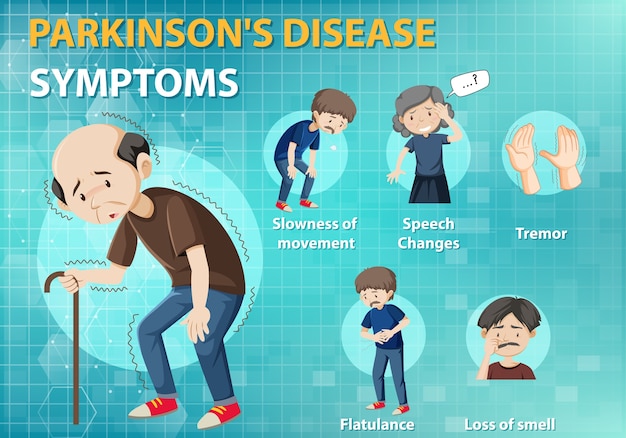Parkinson’s Disease: Definition, Characteristics, Causes, Treatment and MCQs for NEET, GPAT, CSIR NET JRF
“Parkinsonism is a syndrome of chronic progressive disorder of motor function and is clinically characterized by tremors.”
CHARACTERISTICS: –
As Parkinsonism is a clinical disease, so it is characterized by following:
- Diminished facial expression
- Stooped posture
- Slowness of voluntary movement
- Festinating gaint
- Rigidity
- Pill – rolling tremor
- Changes in mental function
The disease comes on in later life.

The above image is taken for education purpose only from freepik.com
CAUSES: –
The dopaminergic neurons of substantia nigra project to striatum and their degeneration in Parkinson’s disease is associated with reduction in striatal dopamine content.
Also cause by poisoning by CO, manganese and 1-methyl-4-phenyl-1,2,3,6-tetrahydropyridine (MPTP).
Action of monoamine oxidase is required for MPTP toxicity.
TREATMENT: –
Increase dopamine formation of nigrostriatal neuron by administrating L-dopa, precursor of dopamine.
Following are drugs used in the treatment of Parkinson’s disease:
- Benztropine (Cogentin)
- Trihexyphenidyl (Artane)
- Apomorphine (Apokyn)
- Bromocriptine (Parlodel)
- Pramipexole (Mirapex)
- Pramipexole ER (Mirapex ER)
- Ropinirole (Requip)
- Ropinirole XL (Requip XL)
- Rotigotine (Neupro)
MULTIPLE CHOICE QUESTIONS: –
1.] Parkinson’s disease is only seen in people of advanced age?
a. True
b. False
2.] What does the body’s nervous system control?
a. The five senses
b. Body weight
c. Body temperature
d. All of the above
3.] What causes Parkinson’s disease?
a. A severe blood infection
b. Loss of the brain chemical dopamine
c. Stroke
d. Depression
4.] There are how many stages of Parkinson’s disease?
a. 2
b. 4
c. 5
d. 7
5.] What are lewy bodies?
a. Protein deposits found in brain
b. Pockets of air found in brain
c. Microscopic crystalline matter found in brain
d. A build of slat found in brain
6.] Who are more likely to develop Parkinson’s disease?
a. Men
b. Women
7.] Dementia is often seen in the later stages of Parkinson’s disease?
a. True
b. False
8.] What is often the first symptom of Parkinson’s disease?
a. Headache
b. Nausea
c. Shaking of hand and foot
d. Turning of the head
9.] How is Parkinson’s disease is diagnosed?
a. With a blood test
b. With a neurological exam
c. With an X-ray
d. All of the above
10.] How is Parkinson’s diseases is treated?
a. Medicine
b. Surgery
c. Radiation
d. Both (a) and (b)
SOLUTIONS: –
1.] (b)
2.] (a) The five senses
3.] (b) Loss of brain chemical dopamine
4.] (c) 5
5.] (a) Protein deposit found in brain
6.] (a) Men
7.] (a)
8.] (c) Shaking of hand and foot
9.] (b) With a neurological examination
10.] (d)
List of Successful GPATINDIAN CANDIDATES
Participate in Online FREE GPAT TEST: CLICK HERE
Participate in Online FREE Pharmacist TEST: CLICK HERE
Participate in Online FREE Drug Inspector TEST: CLICK HERE
Participate in CSIR NET JRF Mock Test
REFERENCES: –
1.] Textbook of Pathology by Harsh Mohan; 7th edition; Page no.877.
2.] Robbin’s Basic Pathology; 5th edition; Page no. 1332 – 1333.